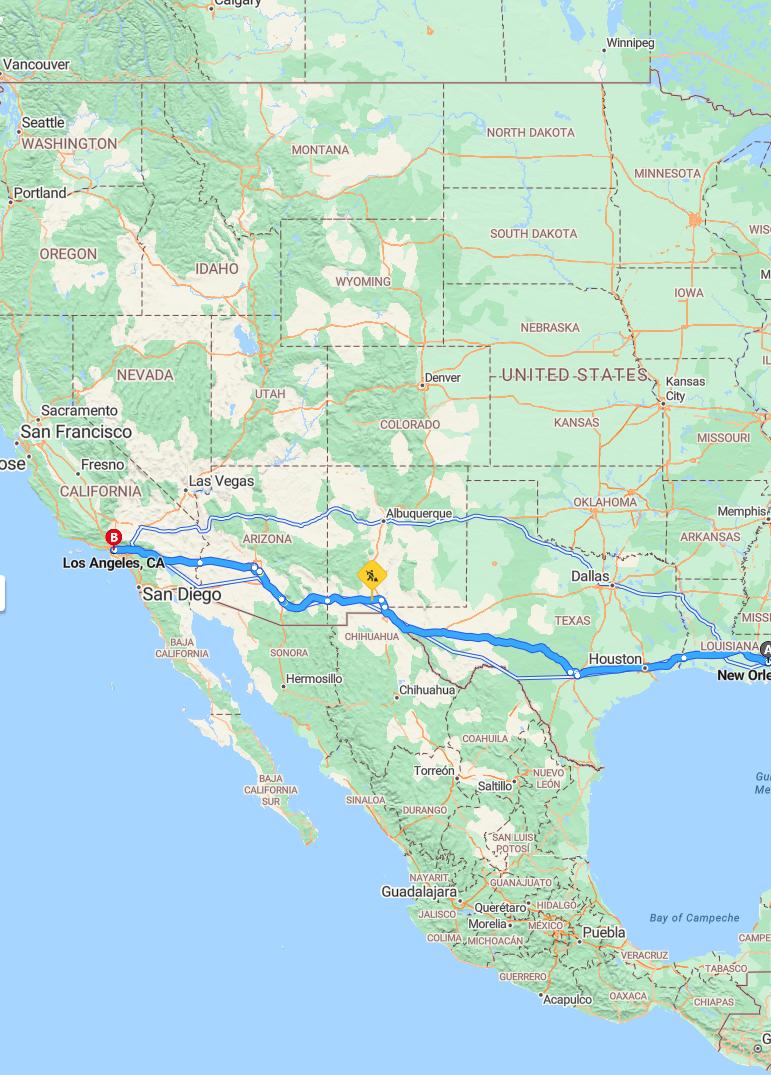Distance and estimated driving time
Driving from New Orleans to Los Angeles along I-10 W covers approximately 1,894 miles and typically takes around 26 hours and 35 minutes. This route offers an efficient cross-country journey through diverse landscapes and major cities. Planning ahead for rest stops, fuel, and potential delays can help ensure a smooth trip. Overall, it is an extensive drive that requires careful preparation and time management.
Driving route
Embarking on a road trip from New Orleans, LA, to Los Angeles, CA, offers an exciting journey through diverse landscapes and vibrant cities. Starting in New Orleans, you can enjoy its rich cultural heritage and lively music scene before heading northwest toward Houston, TX, a major metropolis known for its space center and diverse cuisine. Continuing your drive, San Antonio, TX, provides a blend of historic sites like the Alamo and scenic river walks, making it a great stop to explore local history and culture. As you make your way west across Texas, the scenery shifts from urban to more open plains, culminating in the entertainment capital of the world--Los Angeles, CA. This route showcases a mix of southern charm, Texan hospitality, and California modernity, making for a memorable cross-country adventure.

Essential travel preparations and safety tips
Before embarking on a long road trip from New Orleans to Los Angeles, it is essential to prepare thoroughly. Ensure your vehicle is in optimal condition by checking tire pressure, fluid levels, and brakes, and carry a spare tire and emergency kit. Plan your route in advance, including rest stops in Houston and San Antonio, to stay refreshed and alert, and keep an emergency supplies kit handy with water, snacks, and first aid essentials. Additionally, prioritize safety by adhering to speed limits, avoiding distracted driving, and taking regular breaks to prevent fatigue during the journey.
Best pit stops and sightseeing opportunities along the way
Traveling from New Orleans to Los Angeles offers an array of exciting pit stops and sightseeing opportunities. In Houston, visitors can explore the Space Center Houston or enjoy delicious cuisine in lively neighborhoods. San Antonio boasts the iconic Alamo and scenic River Walk, perfect for a leisurely stroll and vibrant nightlife. Approaching Los Angeles, travelers can visit scenic spots like Palm Springs or Joshua Tree National Park, making the journey as memorable as the destination itself.
Accommodation options for overnight stays
Travelers driving from New Orleans to Los Angeles have a variety of accommodation options for overnight stays along the route. In Houston and San Antonio, visitors can choose from numerous hotels, motels, andExtended Stay options, ranging from budget-friendly inns to luxury resorts. As you approach Los Angeles, a vibrant selection of accommodations awaits, including well-known hotel chains, boutique lodges, and Airbnb rentals. Planning ahead ensures comfortable overnight stays, allowing travelers to rest and explore the sights along this scenic cross-country journey.
Weather forecast and driving conditions
The weather forecast for the driving route from New Orleans to Los Angeles predicts mild to moderate conditions, with a mix of sunny skies and occasional clouds. Travelers can expect, particularly in Texas, some periods of rain and possible thunderstorms, which may impact driving visibility and road safety. As you approach Southern California, the weather generally improves with clear skies, although high temperatures could lead to dry, dusty conditions. Overall, drivers should stay alert to changing weather patterns, adhere to traffic advisories, and prepare for varying road conditions throughout their journey.
Vehicle maintenance tips for long road trips
Before embarking on a long road trip from New Orleans to Los Angeles, it is essential to perform thorough vehicle maintenance to ensure a safe and hassle-free journey. Check the tire pressure and tread depth, and ensure all fluids, including oil, coolant, and windshield washer fluid, are at appropriate levels. Inspect the brake system and lights to guarantee proper functioning, and consider a comprehensive engine check-up with a professional mechanic. Lastly, pack an emergency kit with essentials such as spare tires, jumper cables, and basic tools, so you're prepared for any unexpected situations on the road through Houston, San Antonio, and ultimately to Los Angeles.
Local cuisine and dining recommendations
Traveling from New Orleans to Los Angeles offers an exciting culinary journey through diverse regional flavors. In New Orleans, don't miss the iconic Creole and Cajun dishes like gumbo and jambalaya at local favorites such as Commander's Palace. In Houston, indulge in authentic Tex-Mex cuisine and barbecue at renowned spots like Pink's BBQ or El Tiempo Cantina. As you reach San Antonio, savor traditional Texan specialties such as enchiladas and puffy tacos, with plenty of options along the River Walk. Finally, in Los Angeles, explore the vibrant food scene with diverse offerings ranging from trendyCalifornia sushi bars to authentic Mexican eateries, ensuring a flavorful end to your road trip.
Budget estimation for the entire trip
Planning a road trip from New Orleans to Los Angeles involves estimating various costs to stay within your budget. The total distance between these cities is approximately 2,000 miles, covering major stops in Houston and San Antonio, TX, before reaching Los Angeles. Key expenses include fuel, which varies depending on vehicle efficiency, tolls, food, lodging, and possible vehicle maintenance. On average, a road trip of this length could cost around $300 to $600, factoring in fuel, accommodation, and food, making it essential to plan ahead for a smooth and affordable journey.
Travel advisories and road closures
Travel advisories and road closures can significantly impact your journey from New Orleans to Los Angeles. Currently, travelers should check for any updates regarding construction or maintenance work in Houston and San Antonio, which might cause delays or detours. It is advisable to verify real-time conditions before departure, particularly in areas prone to severe weather or accidents. Staying informed through official transportation websites ensures a smoother trip and helps avoid unexpected closures along the route.
